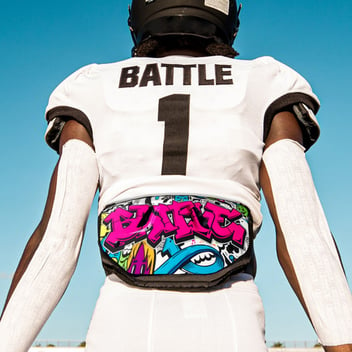What Size Back Plate to Get for Football

Whether you’re a parent or a player yourself, you might be wondering what size back plate to get football players for optimal performance. Luckily, the process for finding the perfect back plate for optimal performance and maximum protection is pretty simple: Find one you like, take a few measurements, and hit the field with your new drip.
Even still, there’s a lot to consider ahead of a back plate purchase related to sizing.
Below, we’ll break down adult vs youth back plate sizing, explain why sizing is so critical, and share tips on how to make sure your back plate fits.

Battle Sports Back Plate Sizes: Adult and Youth Dimensions
First, let’s break down what back plate sizes look like at Battle Sports: your source for player-approved football gear.
- Our youth back plates are typically 9.5 inches wide and 5.75 inches tall. They’re primarily designed for players shorter than 5 foot 4 inches, and they work best for players who weigh 100 pounds or less.
- Our adult back plates measure around 11.5 inches wide and 6.5 inches tall for extra protection. They’re made for players taller than 5 foot 4 inches and weighing more than 100 pounds.
But what if you’re on the borderline between sizes?
When to Choose Adult Size
If you discover that you’re in between back plate sizes while shopping for football drip, you might not be sure whether to size up or down.
In the case of back plates, you should go up to the adult size if:
- You’re growing fast – In the middle of a growth spurt? Bulking hard at the gym? Size up for a future-proof solution.
- You meet the height requirement – Since the dimensions of the back plate determine coverage, you should get the adult size (with more coverage) if you meet the recommended height—even if you’re a little underweight for it.
When to Choose Youth Size
When should you opt for the youth-size football back plate? You might be a better fit for the smaller size if:
- You have a small stature – Even if you’re an adult, you simply might be a better fit for a smaller model. A back plate that’s too large could interfere with your mobility.
- You’re done growing – If you seem to be tapering off after a big growth spurt, it might not make sense to buy a back plate that’s slightly too big right now. You can always size up when you need to, but for now, focus on getting protection for the physique you currently have.
Why Choosing the Right Size Back Plate Matters
Why make back plate size such a federal issue? Because, like any other piece of protective equipment, back plates need to fit well to be effective. They need to properly absorb impact and reduce the chance of injury during intense games.
Think about it—a back plate covers your lower back and upper butt areas from impact. They spread out contact over a larger surface area to soften blows and prevent injuries.1 If a piece of protective gear does not cover an area, that area will not be protected from impact. It’s just that simple.
To get the intended amount of protection a back plate offers, you need to get one that covers your lower back and the top of your butt completely. If it’s too narrow, it might not protect your sides; if it’s too short, it won’t cover your tailbone.
When selecting gear, it's also worth considering the specific needs of different positions. For example, do linemen wear back plates as part of their protective setup? Check out our blog to find out.

How to Ensure a Proper Fit for Maximum Protection
How can you make sure your back plate fits perfectly? By checking for adjustments and monitoring your mobility while wearing it.
Checking Fit and Adjustability
The first time you don a back plate, check that it’s:
- Covering enough areas – A back plate should cover your lower back and the top of your butt. While it doesn’t have to extend past your sides, you want it to cover as much of your back as possible.
- The right height – Most back plates can be adjusted to hang from your shoulder pads at just the right height. Move to a higher or lower attachment point if needed.
The height adjustment is pretty much the only one to make while trying on a back plate. If you still can’t get it to sit in the right spot in any of the height positions, consider trying a different size or a different model.
Testing for Mobility and Range of Motion
Most importantly, you’ll want to playtest a back plate as soon as you can—even if it fits perfectly in the mirror.
A back plate shouldn’t impede your mobility while running, throwing, tackling, or falling. While you’ll likely feel it while you’re wearing it, it shouldn’t feel too heavy or get in the way of playing as you normally would.
And, as always, we recommend trying out new gear at practice—only tried and tested equipment should make the cut on game day.
Find Your Ideal Back Plate with Battle Sports
Not sure what size back plate to get football stars in your life? Measurement, adjustment, and testing are all key. It’s hard to eyeball the perfect protective equipment, but you’ll know it when you feel it.
Start your search for the perfect back plate (and your whole football kit) at Battle Sports. Pair your back plate with our top-rated football gloves and football mouthguards for a complete gear setup. We’re the headquarters of the best gear on the market, and we can help you take your ‘fit to the next level.
Check out what’s new and discover the best in football swag.
Sources:
- Battle Sports. What Is a Back Plate and Why Is It Needed?. https://blog.battlesports.com/what-is-a-back-plate-and-why-is-it-needed



